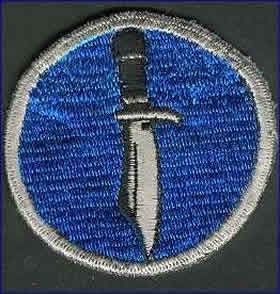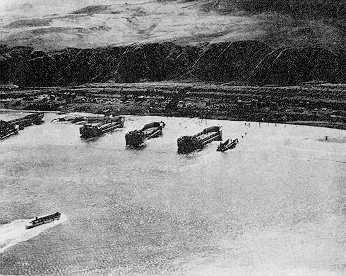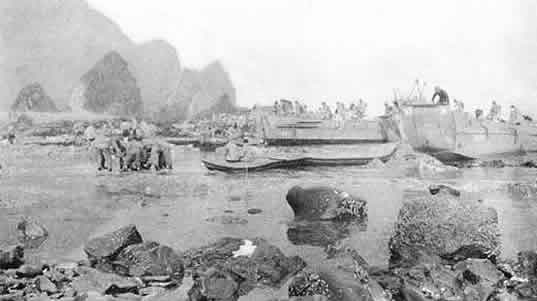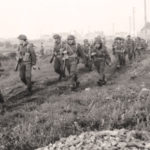June 1943 – January 1944

The Japanese attacked and occupied Attu and Kiska Alaska on 7 Jun 42. During the Spring of 1943 it was decided by the Canadian government to send a force in the recovery of these islands. A force was to be assigned to assist the Americans in their assault on Kiska, scheduled for September 1943.
By 2 Jun 43 the basic order of battle was decided. The 13th Canadian Infantry Brigade would consist of the Winnipeg Grenadiers, the Rocky Mountain Rangers and the Canadian Fusiliers. Other formations consisted of Twenty Fourth Field Regiment (Royal Canadian Artillery), The Twenty Fourth Field Company (Royal Canadian Engineers), a machine gun company from the Saint John Fusiliers and various service detachments. The brigade would be called GREENLIGHT FORCE.
Private Henri Richard wasn’t initially a member of GREENLIGHT FORCE. He had been assigned to the Midland Regiment in Terrace, BC, where the army was busy building an airfield. But on 7 Jun 43 it was decided that any soldier who had been enlisted after 15 Feb 43 was too “fresh” to fight a seasoned and dug in enemy on Kiska. Due to this ruling the Winnipeg Grenadiers lost 52 men, but gained 196 new soldiers, including Private Henri Richard who was transferred to the regiment on 8 Jun 43.
At this point events happened particularly fast for Henri. The assault was initially scheduled for September, but now it was moved ahead to August. Also, once soldiers arrived in Courtenay, BC, a rigorous training regime was put in place. This training was designed to prepare them for the peculiar conditions they would face on Kiska Island. They had to prepared to run up mountains and fight in biting cold winds. All members of the force had to be in top-notch physical shape.
More Kiska Pages
On 12 Jul 43 the brigade boarded four US transport ships in the ports of Nanaimo and Chemainus and headed north for Adak, Alaska. At this time a total of 165 men were reported absent without leave. Pacific Command attributed these absences were due to “a feeling of discourse among the men”. This was created when within the space of a month, or less, about one third of existing personnel were shuffled from one unit to another.
 The force arrived in Adak on 21 Jul 43. While on Adak, GREENLIGHT FORCE troops were kept busy with marches (physical training) and individual and sub-unit training, the latter emphasizing battle drill and patrolling tactics. The high point of the training was an amphibious landing exercise held on Great Sitkin Island during the first week of August. General Buckner and Rear Admiral Thomas C. Kincaid, the US Navy’s senior officer in Alaska, both expressed favorable opinions about the appearance and bearing of the Canadians.
The force arrived in Adak on 21 Jul 43. While on Adak, GREENLIGHT FORCE troops were kept busy with marches (physical training) and individual and sub-unit training, the latter emphasizing battle drill and patrolling tactics. The high point of the training was an amphibious landing exercise held on Great Sitkin Island during the first week of August. General Buckner and Rear Admiral Thomas C. Kincaid, the US Navy’s senior officer in Alaska, both expressed favorable opinions about the appearance and bearing of the Canadians.
While on Adak, GREENLIGHT FORCE was also issued American environmental clothing (parkas), medical supplies and assigned American vehicles, though few vehicles would be used in the mountainous terrain of Kiska.
On 13 August the transport ships departed from Adak for Kiska, and were accompanied later by the US navy ships Pennsylvania, Idaho, Tennessee, Santa Fe andtheir escorts. Prior to the landing, a heavy bombardment of Kiska was undertaken from both the air and the sea. On the day of the invasion, the landing plan was to provide a bombardment and feint landing on the south side of the island, then complete the real landings on the west and northwest sides on the 15th and 16th of August.

GREENLIGHT FORCE landed upon a rocky beach on the northwest side of Kiska on 16 Aug 43, a day after the American troops landed further south. The brigade was to move inland as quickly as possible as they sought an enemy believed to have withdrawn into the hills. The Canadians followed a ravine up into the hills, cautiously approaching two nearby gun emplacements and several machine gun nests, all of which were luckily unmanned. Despite heavy fog all troops reached and surpassed their initial goals. Of course no enemy was to be found. The only thing there was a friendly dog left behind by the Japanese.
There were many who thought that the Japanese were in every cave and behind every rock in these days of the invasion. American forces reported contact with Japanese riflemen in the fog and wild shooting took place. Of the Americans 28 soldiers were dead and another 50 wounded after the first two days on the island. Only 4 of the dead and several of the wounded were actually of the result of Japanese mines and booby traps. The Canadians meanwhile, accounted for 4 dead and another 4 wounded, all the cause of Japanese munitions. (There is another source which does indicate that one of the Canadian wounded was the cause of “unidentified machine gun fire.”)

only living opposition force on Kiska.
Stories of caves found with coffee pots “still hot” and in Henri’s case, a story of “bowls of rice still warm on the table” were later discovered to be a case of a soldier’s imagination acting up and regimental rumors running rampant. Once the war ended it was finally discovered that all Japanese forces had been taken off the Island a full three weeks prior to the landing. It is believed that the main Japanese evacuation took place on or about 28 July. The departure had taken 1 hour and was done in dense fog, a feat within itself, although the Japanese force did leave most of their weapons and equipment behind.
Many soldiers expressed regret that the Japanese weren’t there. In one report it was stated “When we got there, the cupboard was bare.” Deep down though there was a sigh of relief. Of the 5300 Canadian men that were sent to Kiska, it was initially expected that 1800 would be casualties.
The GREENLIGHT FORCE remained on Kiska as a garrison for more than 3 months, living in “winterized” tents, and engaged in road and pier construction and other general duties. Fog, rain and wind made the island an unpleasant place at the best of times. The Canadian troops finally started to come home in November 1943.
Henri was one of the last to leave Kiska, on or near 7 Jan 44. He arrived home in St. Genevieve, MB, in the middle of a cold January 1944 night to the surprise of his family. It was then that Henri astonished his family with stories of Kiska and told them of the army life that he grown accustomed to.
Note for clarification purposes: Another Canadian Force participated in he Kiska Invasion. The First Special Service Force, made up of Canadian and American (40/60% ratio) troops, was not related in any way to the GREENLIGHT FORCE.



